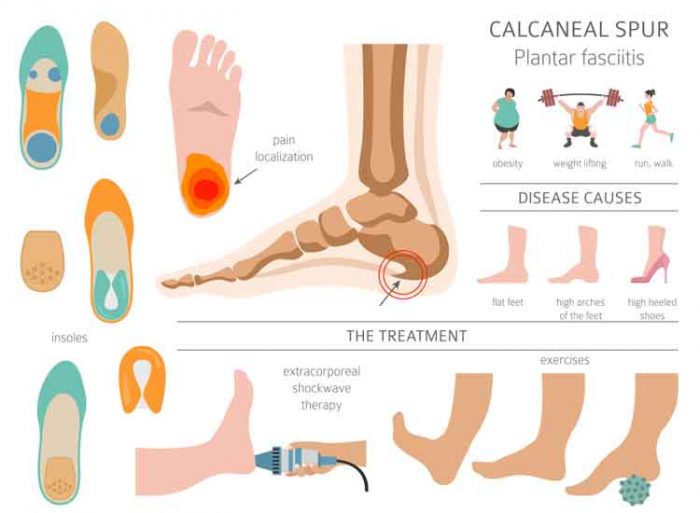Plantar fasciitis is a common foot condition affecting almost 2million Americans. Small tears in the plantar fascia ligament lead to inflammation that causes heel pain.
Plantar fasciitis pain is felt near the heel bone (calcaneous bone) and is worse first thing in the morning, because the plantar fascia ligament tightens overnight. The first few steps in the morning are the most painful, but being off the foot for a while and then standing up will cause the same pain, which can be severe, to recur.
Causes of Plantar Fasciitis Foot Pain

Ligaments are made to stretch with movement. However, too much movement or activity or abnormal stress on a part of the ligament leads to small tears in the ligament. Continued activity or repetitive stress leads to inflammation in and around the ligament. Some things that lead to tears in the plantar fascia by putting extra stress on the ligament are:
• new activity or a change in activity
• unusual gait, such as flat feet, over-pronation, or high arches
• overweight
• poor fitting footwear that forces the foot into an abnormal position
• certain diseases, such as arthritis and diabetes can lead to inflammation in the foot.
Adding Heel Spur Pain to the Pain From Plantar Fasciitis
Pain from the torn and inflamed ligament may be made even worse if a heel spur, a bony fragment that grows from the heel bone, develops with the stress from plantar fasciitis on the foot. This happens when the plantar fascia is pulled away from the heel bone repeatedly. Heel spurs, which can be seen on X-ray, can occur without plantar fasciitis, but frequently develop in conjunction with it.
Plantar Fasciitis, Heel Spurs Pain Treatment with Splints, Ultrasound, Injections and Orthotics
Correcting the abnormal mechanics goes a long way in treating plantar fasciitis. Anti inflammatory medications reduce inflammation, and decreasing the offending activity allows the torn ligament to heal. Plantar fasciitis can be treated with cortisone injections into the bottom of the foot. Injections are painful for a few hours or so, but as the steroid reduces inflammation, pain improves, although the improvment may be only temporary. Cortisone injections can weaken the ligament and cause it to rupture, so can’t be used more than a few times.
Plantar fasciitis and heel spurs can also be both treated and prevented with night splints and orthotics. Night splints keep the ligament stretched over night, so it can’t tighten up; this greatly reduces the morning pain of plantar fasciitis. Orthotics, which fit in the shoe and are worn during the day, keep the foot in better alignment so that tears don’t develop from an abnormal gait.
Ultrasonic shock wave therapy, called extracorporeal shock-wave therapy (ESWT) can be helpful in some cases. Stretching the Achilles tendon by by doing exercises that flex the foot may also be helpful.. If all other treatments fail, surgery to may be considered, but studies show long term results are not positive.
Avoiding Further Episodes of Pain From Plantar Fasciitis and Heel Spurs
Wearing orthotics and proper footwear go a long way to prevent recurrence of plantar fasciitis foot pain. So do losing weight and avoiding extra stress on the foot during exercise. Taking care of feet can prevent painful heel problems later.

